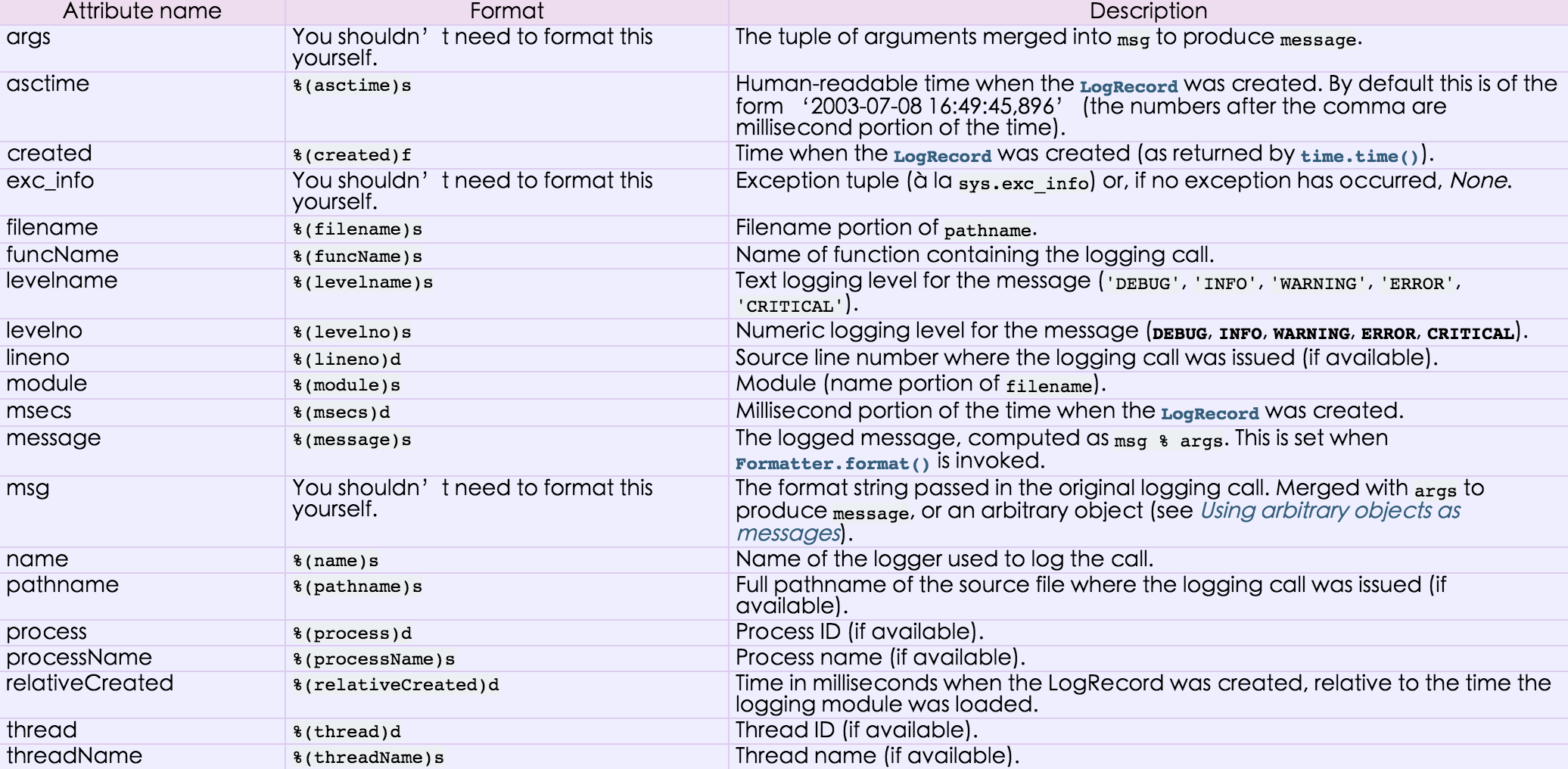Python学习笔记——基础篇【第六周】——logging模块
常用模块之logging
用于便捷记录日志且线程安全的模块
import logging logging.basicConfig(filename='log.log',
format='%(asctime)s - %(name)s - %(levelname)s -%(module)s: %(message)s',
datefmt='%Y-%m-%d %H:%M:%S %p',
level=10) logging.debug('debug')
logging.info('info')
logging.warning('warning')
logging.error('error')
logging.critical('critical')
logging.log(10,'log')
对于等级:
CRITICAL = 50
FATAL = CRITICAL
ERROR = 40
WARNING = 30
WARN = WARNING
INFO = 20
DEBUG = 10
NOTSET = 0
只有大于当前日志等级的操作才会被记录。
对于格式,有如下属性可是配置:

---------------------------------------------------------------------------------------------
很多程序都有记录日志的需求,并且日志中包含的信息即有正常的程序访问日志,还可能有错误、警告等信息输出,python的logging模块提供了标准的日志接口,你可以通过它存储各种格式的日志,logging的日志可以分为 debug(), info(), warning(), error() and critical() 5个级别,下面我们看一下怎么用。
最简单用法
import logging
logging.warning("user [alex] attempted wrong password more than 3 times")
logging.critical("server is down")
#输出
WARNING:root:user [alex] attempted wrong password more than 3 times
CRITICAL:root:server is down
看一下这几个日志级别分别代表什么意思
| Level | When it’s used |
|---|---|
DEBUG |
Detailed information, typically of interest only when diagnosing problems. |
INFO |
Confirmation that things are working as expected. |
WARNING |
An indication that something unexpected happened, or indicative of some problem in the near future (e.g. ‘disk space low’). The software is still working as expected. |
ERROR |
Due to a more serious problem, the software has not been able to perform some function. |
CRITICAL |
A serious error, indicating that the program itself may be unable to continue running. |
如果想把日志写到文件里,也很简单
import logging logging.basicConfig(filename='example.log',level=logging.INFO)
logging.debug('This message should go to the log file')
logging.info('So should this')
logging.warning('And this, too')
其中下面这句中的level=loggin.INFO意思是,把日志纪录级别设置为INFO,也就是说,只有比日志是INFO或比INFO级别更高的日志 才会被纪录到文件里,在这个例子, 第一条日志是不会被纪录的,如果希望纪录debug的日志,那把日志级别改成DEBUG就行了。
logging.basicConfig(filename='example.log',level=logging.INFO)
感觉上面的日志格式忘记加上时间啦,日志不知道时间怎么行呢,下面就来加上!
import logging
logging.basicConfig(format='%(asctime)s %(message)s', datefmt='%m/%d/%Y %I:%M:%S %p')
logging.warning('is when this event was logged.') #输出
12/12/2010 11:46:36 AM is when this event was logged.
如果想同时把log打印在屏幕和文件日志里,就需要了解一点复杂的知识 了
The logging library takes a modular approach and offers several categories of components: loggers, handlers, filters, and formatters.
- Loggers expose the interface that application code directly uses.
- Handlers send the log records (created by loggers) to the appropriate destination.
- Filters provide a finer grained facility for determining which log records to output.
- Formatters specify the layout of log records in the final output.
import logging #create logger
logger = logging.getLogger('TEST-LOG')
logger.setLevel(logging.DEBUG) # create console handler and set level to debug
ch = logging.StreamHandler()
ch.setLevel(logging.DEBUG) # create file handler and set level to warning
fh = logging.FileHandler("access.log")
fh.setLevel(logging.WARNING)
# create formatter
formatter = logging.Formatter('%(asctime)s - %(name)s - %(levelname)s - %(message)s') # add formatter to ch and fh
ch.setFormatter(formatter)
fh.setFormatter(formatter) # add ch and fh to logger
logger.addHandler(ch)
logger.addHandler(fh) # 'application' code
logger.debug('debug message')
logger.info('info message')
logger.warn('warn message')
logger.error('error message')
logger.critical('critical message')
参考链接:
http://www.cnblogs.com/alex3714/articles/5161349.html
http://www.cnblogs.com/wupeiqi/articles/4963027.html
Python学习笔记——基础篇【第六周】——logging模块的更多相关文章
- Python学习笔记——基础篇【第一周】——变量与赋值、用户交互、条件判断、循环控制、数据类型、文本操作
目录 Python第一周笔记 1.学习Python目的 2.Python简史介绍 3.Python3特性 4.Hello World程序 5.变量与赋值 6.用户交互 7.条件判断与缩进 8.循环控制 ...
- Python学习笔记——基础篇【第二周】——解释器、字符串、列表、字典、主文件判断、对象
目录 1.Python介绍 2.Python编码 3.接受执行传参 4.基本数据类型常用方法 5.Python主文件判断 6.一切事物都是对象 7. int内部功能介绍 8.float和long内 ...
- Python学习笔记基础篇——总览
Python初识与简介[开篇] Python学习笔记——基础篇[第一周]——变量与赋值.用户交互.条件判断.循环控制.数据类型.文本操作 Python学习笔记——基础篇[第二周]——解释器.字符串.列 ...
- Python学习笔记——基础篇【第七周】———类的静态方法 类方法及属性
新式类和经典类的区别 python2.7 新式类——广度优先 经典类——深度优先 python3.0 新式类——广度优先 经典类——广度优先 广度优先才是正常的思维,所以python 3.0中已经修复 ...
- Python学习笔记——基础篇【第五周】——常用模块学习
模块介绍 本节大纲: 模块介绍 time &datetime模块 (时间模块) random (随机数模块) os (系统交互模块) sys shutil (文件拷贝模块) j ...
- Python 学习笔记---基础篇
1. 简单测试局域网中的电脑是否连通.这些电脑的ip范围从192.168.0.101到192.168.0.200 import subprocess cmd="cmd.exe" b ...
- Python成长笔记 - 基础篇 (六)python模块
本节大纲: 模块介绍 time &datetime模块 random os sys shutil json & picle shelve xml处理 yaml处理 configpars ...
- Python学习笔记——基础篇【第六周】——面向对象
Python之路,Day6 - 面向对象学习 本节内容: 面向对象编程介绍 为什么要用面向对象进行开发? 面向对象的特性:封装.继承.多态 类.方法. 同时可参考链接: http:// ...
- Python学习笔记——基础篇【第六周】——json & pickle & shelve & xml处理模块
json & pickle 模块(序列化) json和pickle都是序列化内存数据到文件 json和pickle的区别是: json是所有语言通用的,但是只能序列化最基本的数据类型(字符串. ...
随机推荐
- C# BackgroundWorker组件学习
C# BackgroundWorker组件学习 C# BackgroundWorker组件学习 一个程序中需要进行大量的运算,并且需要在运算过程中支持用户一定的交互,为了获得更好的用户体验,使用Ba ...
- C/C++ 中 const 修饰符用法总结
C/C++ 中 const 修饰符用法总结 在这篇文章中,我总结了一些C/C++语言中的 const 修饰符的常见用法,供大家参考. const 的用法,也是技术性面试中常见的基础问题,希望能够帮大家 ...
- 使用 Aspose.Cells 实现 excel导入
using System; using System.Collections.Generic; using System.Linq; using System.Web; using System.We ...
- JS二维数据处理逻辑封装探究
一.目的 定义出一个专门用于处理二维数据的组件,所谓二维数据就是能用二维表格显示出来的数据,所谓处理就是增删改查,很简单. 二.约束 外部程序给该组件传入如下形式的对象,让该组件自行解析. var t ...
- 从0开始LInux配置PHP开发环境
主要参考 http://www.cnblogs.com/Fly-sky/p/3770305.html 次要参考 http://www.cnblogs.com/mchina/archive/2012/1 ...
- 我的Emacs折腾经验谈(一) 一些给新人的建议
这几天都没有动力写mongodb的东西,我果然还是太懒了么~ 主要是没有一个系统的东西整理出来,加上我令人拙计的语言表达能力,这个坑只能慢慢再补了. 最近在折腾emacs这个东西,首先说我曾经算是个极 ...
- .NET依托CLR进行的内存的管理
看了http://www.cnblogs.com/liulun/p/3145351.html 不错,补习下相关技术.. 正文: .NET依托CLR进行的内存的管理 有了CLR 基本不需要担心.net ...
- java.util.List 的大小
今天在看API的时候,忽然看见List对象的size()方法返回的是int类型,于是就想知道是不是只能存放int的最大数值2147483647个. 但是,用自己电脑跑了一下,代码如下: public ...
- gRPC helloworld service, RESTful JSON API gateway and swagger UI
概述 本篇博文完整讲述了如果通过 protocol buffers 定义并启动一个 gRPC 服务,然后在 gRPC 服务上提供一个 RESTful JSON API 的反向代理 gateway,最后 ...
- 结构-行为-样式-Jquery实现延迟加载特效(数据缓冲特效)
最近在做一个地产项目的过程中,原来用的延迟加载的插件在IE下会使浏览器突然缩小,这个让客户很不满意,于是就考虑到兼容性的问题决定自己写一个插件.思路:定义一个代码块,手动加载到页面,然后手动删除. ...
